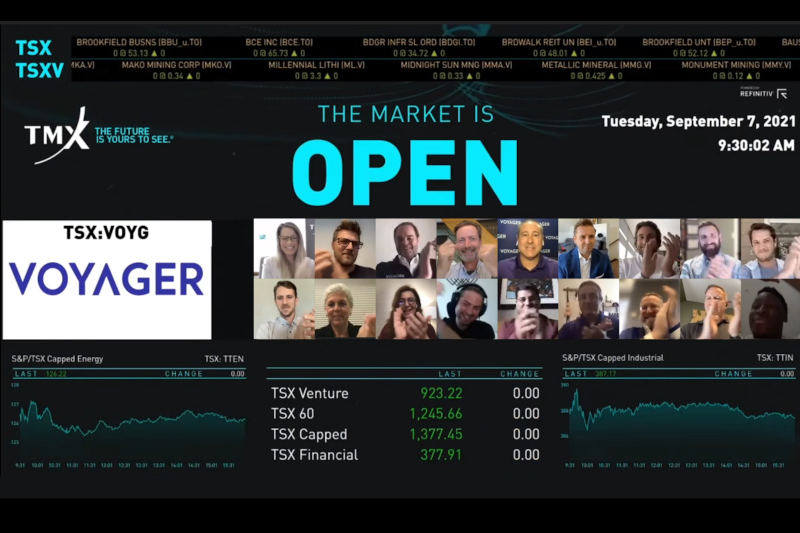
Voyager Digital Partners with Fundstrat to Provide Market-leading Crypto Research to Users
Voyager makes strategic investment in Fundstrat, an independent research boutique
NEW YORK, Oct. 1, 2021 /PRNewswire/ – Voyager Digital Ltd. (“Voyager” or the “Company”) (TSX: VOYG) (OTCQX: VYGVF) (FRA: UCD2) one of the fastest-growing, publicly traded cryptocurrency platforms in the United States, today announced a strategic investment and partnership with Fundstrat, a leading research boutique led by Wall Street strategist Thomas Lee and veteran Wall Street sales executive John Bai, to be Fundstrat‘s exclusive US partner and incorporate crypto research into the Voyager platform.
“We believe research is crucial for traders, which is why we’re bringing valuable market data and insights right into the Voyager platform,” said Steve Ehrlich, CEO and Co-founder of Voyager. “We want to make research more accessible for our customers, and also provide resources for new investors entering the crypto space. One of the key parts of the crypto journey is education as the industry is constantly evolving. There’s so much to learn and we want to make it easy and convenient for our users to do so.”
Fundstrat is an independent research boutique that provides market strategy and sector research, including digital asset research. Voyager’s partnership with Fundstrat allows the Company to deliver crypto market intelligence to Voyager’s customers. The research and content will be co-branded by the two companies and available on the Voyager platform.
“As one of the leading cryptocurrency platforms in the world, Voyager shares the same vision as we do in building a community and supporting them through education and insights,” said John Bai, Managing Partner at Fundstrat. “We’re thrilled to be partnering with Voyager to grow and achieve this goal.”
Voyager will be purchasing Units of Fundstrat, for an aggregate purchase price of approximately US$6,000,000 to be satisfied by the issuance of 601,504 common shares of Voyager.
About Voyager Digital Ltd.
Voyager Digital Ltd. (TSX: VOYG) (OTCQX: VYGVF) (FRA: UCD2) is a fast-growing, publicly traded cryptocurrency platform in the United States founded in 2018 to bring choice, transparency, and cost efficiency to the marketplace. Voyager offers a secure way to trade over 60 different crypto assets, using its easy-to-use mobile application, and earn rewards up to 12 percent annually on more than 30 cryptocurrencies. Through its subsidiary Coinify ApS, Voyager provides crypto payment solutions for both consumers and merchants around the globe. To learn more about the company, please visit https://www.investvoyager.com.
The TSX has not approved or disapproved of the information contained herein. The Transaction is subject to the satisfaction of certain customary closing conditions, including the receipt of all necessary regulatory and stock exchange approvals, including the approval of the Toronto Stock Exchange.
Press Contacts
Voyager Digital, Ltd.
Michael Legg
Chief Communications Officer
(212) 547-8807
mlegg@investvoyager.com
Voyager Public Relations Team
pr@investvoyager.com
SOURCE Voyager Digital (Canada) Ltd.


 Rakesh joins Voyager from Two Sigma Investments, a technology and data-driven financial services company applying artificial intelligence, machine learning, and distributed computing to investing. At Two Sigma, Rakesh served as Senior Vice President of Engineering, leading the engineering strategy, planning, and technical program management for Two Sigma Investment Management. Rakesh has experience building and scaling high-calibre teams in hyper-growth environments. Over his career, he successfully led engineering teams to deliver eCommerce solutions, high-performance trading systems, financial compliance and risk management systems, and customer-facing websites.
Rakesh joins Voyager from Two Sigma Investments, a technology and data-driven financial services company applying artificial intelligence, machine learning, and distributed computing to investing. At Two Sigma, Rakesh served as Senior Vice President of Engineering, leading the engineering strategy, planning, and technical program management for Two Sigma Investment Management. Rakesh has experience building and scaling high-calibre teams in hyper-growth environments. Over his career, he successfully led engineering teams to deliver eCommerce solutions, high-performance trading systems, financial compliance and risk management systems, and customer-facing websites.








